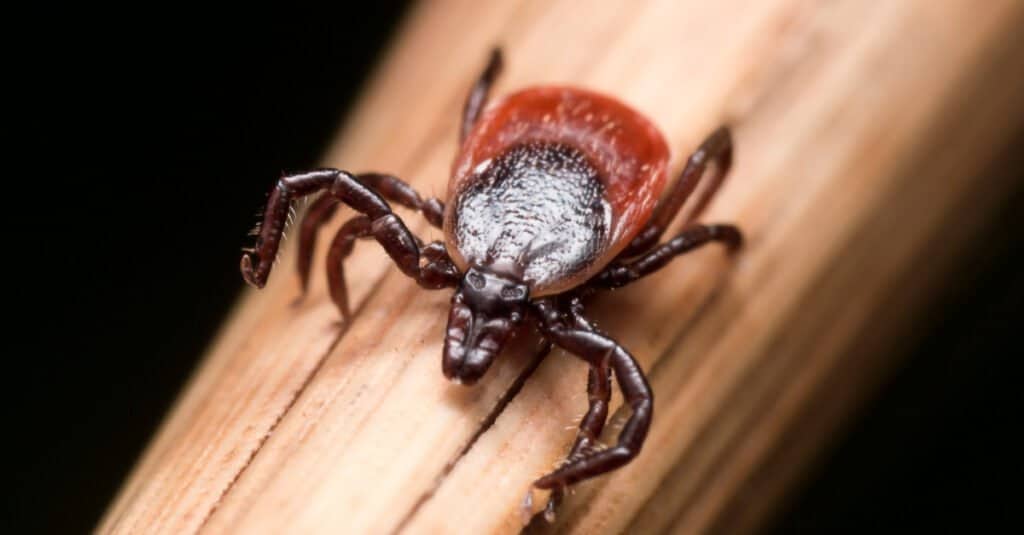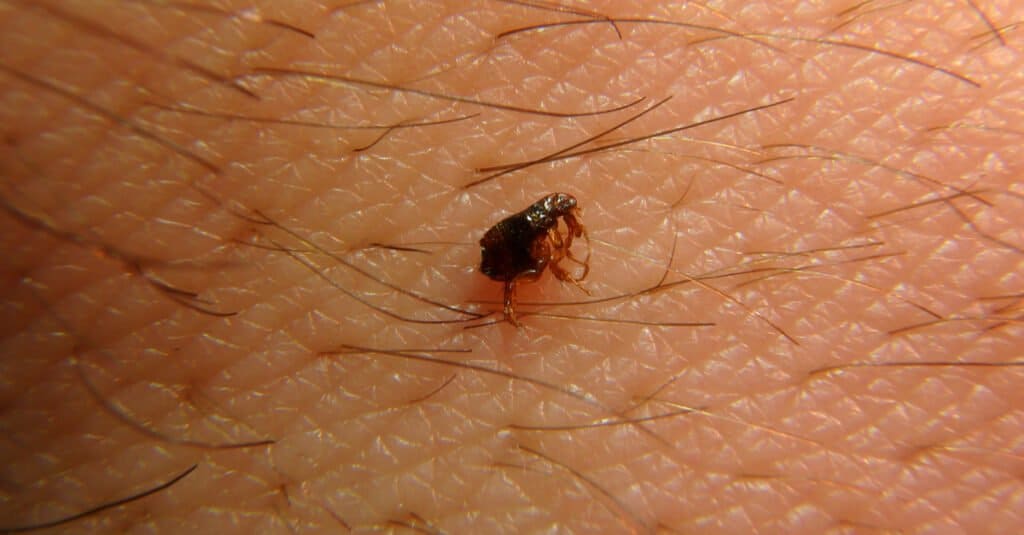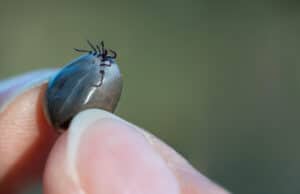Ticks seem to come out of nowhere! Apart from being an annoying end to a lovely day outside, some tick species are downright dangerous. Species like the deer tick, dog tick, and the American Dog tick come with serious health risks. But how do these parasitic pests manage to attach themselves to anywhere on the body? Do ticks fly or jump? Do ticks have wings?
We will explore these questions in the sections below.
Do Ticks Have Wings?

Ticks do not have wings and hence cannot fly.
©Steven Ellingson/Shutterstock.com
Do ticks fly? Ticks do not have wings, but there are instances when a tick may appear to have wings. Ticks are arachnids, but there are some insects that look remarkably similar. These imposter insects may have wings, which can cause confusion! As all species of ticks vary in color and physical appearance, some insects can look like ticks.
There are many kinds of ticks, and they are all members of the arachnid family, like spiders or scorpions. All species are parasites that feed on blood, but only sixty species prey on pets or humans. Ticks can also swell to up to 600 percent of their size when visibly engorged with blood. In the larval stage, ticks only have six legs but have eight legs in their nymph and adult forms.
Nymph Ticks Do not Have Wings
Juvenile ticks, also known as nymphs, do not develop wings when they transition from their larval state. Nymph ticks are particularly dangerous because they are so small it is difficult to detect them. Also, a nymph tick only has six legs, whereas the adult tick has eight. Depending on the location and species, nymph ticks appear between late spring and early summer.
Insects That Look Like Flying Ticks

Some species of stink bugs look very similar to ticks in their nymph stage.
©Lee Hua Ming/Shutterstock.com
There are quite a few insects that look like ticks but are not, and a few of these species have wings. This can cause quite a bit of confusion, but closer inspection will ease your mind! One of the insects commonly confused with a flying tick species is brown marmorated stink bugs. This species of stink bug lacks its standard shield-shaped body when in its nymph stage and can look like a tick.
There are also insects that do not fly but highly resemble ticks. This includes some species of weevil, mites, fleas, and even bedbugs. There are nine hundred species of ticks worldwide. As some species can carry dangerous illnesses like Lyme disease, always treat any tick as though it is one! After removing the possible tick, carefully examine it after the fact.
Make sure to look for a visible bite and to inspect the entire body of the individual or animal affected. When identifying a tick, remember to look for eight legs, no antennae, and a small head on a fused body in its adult form.
Do Ticks Jump?

Ticks cannot jump.
©David Jara Bogunya/Shutterstock.com
Ticks do not jump! Now that we have established that ticks cannot fly, it is time to debunk another common misconception about them. Though ticks seem to come out of nowhere, they cannot jump from host to host. Once a tick has landed on a host, they quickly find a place to bite into the host’s flesh. They use their barbed mandibles and feeding tube to cling to the host, often burrowing their head under the skin. Since ticks also produce a chemical within their mouths that numbs the bite, the host does not even feel it!
Why Ticks Appear To Jump From Host To Host

Ticks find and land on their host by balancing on vegetation using their three back sets of legs.
©iStock.com/dmf87
Ticks are found in densely wooded areas, tall grasses, or anywhere with thick and concealing plant matter. Additionally, the brown dog tick can also live its entire life cycle indoors. Ticks move around by clinging to vegetation using the back three sets of legs. A tick will often select a higher location to increase its chances of detecting a host. Using their first set of legs, ticks can detect the approach of a host and will quickly drop onto the animal or human.
It is also important to note that flea species are also commonly mistaken for ticks. As fleas are also parasitic and feed on blood, mistaking them for ticks is understandable. Unlike ticks, fleas can and do jump! Other insects, such as some mite species and bedbugs, also bite as well. In this case, taking steps to remove these insects in your home often has the benefit of preventing or removing ticks as well!
The photo featured at the top of this post is © Mat Pound-USDA Agricultural Research Service Country-United States / Creative Commons – License / Original
Thank you for reading! Have some feedback for us? Contact the AZ Animals editorial team.






